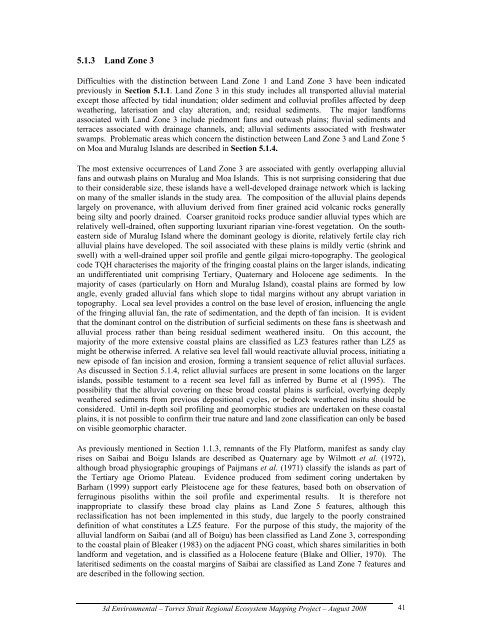Appendix 2 - Vegetation Communities and Regional Ecosystems
Appendix 2 - Vegetation Communities and Regional Ecosystems
Appendix 2 - Vegetation Communities and Regional Ecosystems
Create successful ePaper yourself
Turn your PDF publications into a flip-book with our unique Google optimized e-Paper software.
5.1.3 L<strong>and</strong> Zone 3<br />
Difficulties with the distinction between L<strong>and</strong> Zone 1 <strong>and</strong> L<strong>and</strong> Zone 3 have been indicated<br />
previously in Section 5.1.1. L<strong>and</strong> Zone 3 in this study includes all transported alluvial material<br />
except those affected by tidal inundation; older sediment <strong>and</strong> colluvial profiles affected by deep<br />
weathering, laterisation <strong>and</strong> clay alteration, <strong>and</strong>; residual sediments. The major l<strong>and</strong>forms<br />
associated with L<strong>and</strong> Zone 3 include piedmont fans <strong>and</strong> outwash plains; fluvial sediments <strong>and</strong><br />
terraces associated with drainage channels, <strong>and</strong>; alluvial sediments associated with freshwater<br />
swamps. Problematic areas which concern the distinction between L<strong>and</strong> Zone 3 <strong>and</strong> L<strong>and</strong> Zone 5<br />
on Moa <strong>and</strong> Muralug Isl<strong>and</strong>s are described in Section 5.1.4.<br />
The most extensive occurrences of L<strong>and</strong> Zone 3 are associated with gently overlapping alluvial<br />
fans <strong>and</strong> outwash plains on Muralug <strong>and</strong> Moa Isl<strong>and</strong>s. This is not surprising considering that due<br />
to their considerable size, these isl<strong>and</strong>s have a well-developed drainage network which is lacking<br />
on many of the smaller isl<strong>and</strong>s in the study area. The composition of the alluvial plains depends<br />
largely on provenance, with alluvium derived from finer grained acid volcanic rocks generally<br />
being silty <strong>and</strong> poorly drained. Coarser granitoid rocks produce s<strong>and</strong>ier alluvial types which are<br />
relatively well-drained, often supporting luxuriant riparian vine-forest vegetation. On the southeastern<br />
side of Muralug Isl<strong>and</strong> where the dominant geology is diorite, relatively fertile clay rich<br />
alluvial plains have developed. The soil associated with these plains is mildly vertic (shrink <strong>and</strong><br />
swell) with a well-drained upper soil profile <strong>and</strong> gentle gilgai micro-topography. The geological<br />
code TQH characterises the majority of the fringing coastal plains on the larger isl<strong>and</strong>s, indicating<br />
an undifferentiated unit comprising Tertiary, Quaternary <strong>and</strong> Holocene age sediments. In the<br />
majority of cases (particularly on Horn <strong>and</strong> Muralug Isl<strong>and</strong>), coastal plains are formed by low<br />
angle, evenly graded alluvial fans which slope to tidal margins without any abrupt variation in<br />
topography. Local sea level provides a control on the base level of erosion, influencing the angle<br />
of the fringing alluvial fan, the rate of sedimentation, <strong>and</strong> the depth of fan incision. It is evident<br />
that the dominant control on the distribution of surficial sediments on these fans is sheetwash <strong>and</strong><br />
alluvial process rather than being residual sediment weathered insitu. On this account, the<br />
majority of the more extensive coastal plains are classified as LZ3 features rather than LZ5 as<br />
might be otherwise inferred. A relative sea level fall would reactivate alluvial process, initiating a<br />
new episode of fan incision <strong>and</strong> erosion, forming a transient sequence of relict alluvial surfaces.<br />
As discussed in Section 5.1.4, relict alluvial surfaces are present in some locations on the larger<br />
isl<strong>and</strong>s, possible testament to a recent sea level fall as inferred by Burne et al (1995). The<br />
possibility that the alluvial covering on these broad coastal plains is surficial, overlying deeply<br />
weathered sediments from previous depositional cycles, or bedrock weathered insitu should be<br />
considered. Until in-depth soil profiling <strong>and</strong> geomorphic studies are undertaken on these coastal<br />
plains, it is not possible to confirm their true nature <strong>and</strong> l<strong>and</strong> zone classification can only be based<br />
on visible geomorphic character.<br />
As previously mentioned in Section 1.1.3, remnants of the Fly Platform, manifest as s<strong>and</strong>y clay<br />
rises on Saibai <strong>and</strong> Boigu Isl<strong>and</strong>s are described as Quaternary age by Wilmott et al. (1972),<br />
although broad physiographic groupings of Paijmans et al. (1971) classify the isl<strong>and</strong>s as part of<br />
the Tertiary age Oriomo Plateau. Evidence produced from sediment coring undertaken by<br />
Barham (1999) support early Pleistocene age for these features, based both on observation of<br />
ferruginous pisoliths within the soil profile <strong>and</strong> experimental results. It is therefore not<br />
inappropriate to classify these broad clay plains as L<strong>and</strong> Zone 5 features, although this<br />
reclassification has not been implemented in this study, due largely to the poorly constrained<br />
definition of what constitutes a LZ5 feature. For the purpose of this study, the majority of the<br />
alluvial l<strong>and</strong>form on Saibai (<strong>and</strong> all of Boigu) has been classified as L<strong>and</strong> Zone 3, corresponding<br />
to the coastal plain of Bleaker (1983) on the adjacent PNG coast, which shares similarities in both<br />
l<strong>and</strong>form <strong>and</strong> vegetation, <strong>and</strong> is classified as a Holocene feature (Blake <strong>and</strong> Ollier, 1970). The<br />
lateritised sediments on the coastal margins of Saibai are classified as L<strong>and</strong> Zone 7 features <strong>and</strong><br />
are described in the following section.<br />
3d Environmental – Torres Strait <strong>Regional</strong> Ecosystem Mapping Project – August 2008<br />
41


